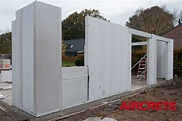What Is Autoclaved Aerated Concrete (AAC)?
- Aircrete Africa
- Feb 16, 2018
- 2 min read
What is Autoclaved Aerated Concrete (AAC)?
Also known as Aircrete, the Autoclaved Aerated Concrete (AAC) is an eco-friendly building material that has been used for all kinds of purposes from around 70 years ago. This material is not only ecologic, non-toxic and really light but also can be easily made at home by anyone with the right tools.

Unlike regular concrete which is hard to work with, AAC has the particularity that it works as a clay and can be shaped in any form wanted with simple wood-carving tools, without rotting or corroding, and with the advantage that it dries overnight.
Reparation of Aircrete is actually really easy as the fresh material can be over put on top of the dry material and it still would seal up during the night. Also, it’s soft enough to take nails and screws and can cost like 10 times less than any other building material.
Advantages of Aircrete
Efficiency
Excellent sound and thermal insulation thanks to the porous surface and good compressive strength. The best part is that according to the thickness of the Autoclaved Aerated Concrete, the construction can adapt to different climate.
Easy and quick building
Foam concrete building material can take any shape and once it dries out in the night, it’s ready to be painted and inhabited as the material has a perfect finish when it’s dried. Also, AAC blocks and panels can help to adapt and repair other constructions but building out of Aircrete entirely is also possible and very safe.
Fire and waterproof
Unlike other materials as wood, AAC is completely fireproof (Euroclass A1) to the point furnaces can be made out of it without any risk. On the other side, water won’t damage Aircrete as it won’t rot or rust in any way.
Building with AAC

Building withAutoclaved Aerated Concrete is actually one of the easiest ways to build anything while being also really cheap. The foam concrete building material can be formed directly to build entire structures such as domes or can be used in blocks or panels for a regular building. It’s really light (up to 5 times lighter than concrete) and manageable and it doesn’t need any isolation material for working with it and with the application of thin joints, the costs are significantly reduced.
The advantages of building with Aircrete, the economy and the fact that it doesn’t need other materials for a high-end finish makes it so economical that it can become a solution for building homes in difficult places or low-resources places. Actually, it could be really useful to use Autoclaved Aerated Concretein Africa or other risk regions where conditions are really hard and resources are scarce.
The fact AAC is really resistant and perdurable with almost no maintenance, the fact a home made out of Aircrete can be shaped according to the space needs, the fact it is fire and waterproof and the reduced cost of making a complete structure out of it makes it the perfect solution for building AAC homes to those ones that can’t actually afford a regular home.




Comments